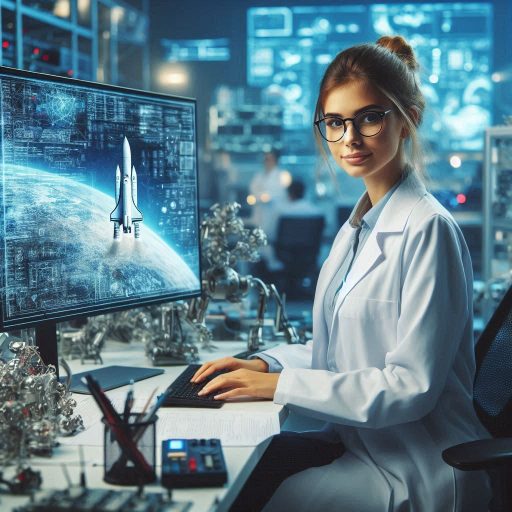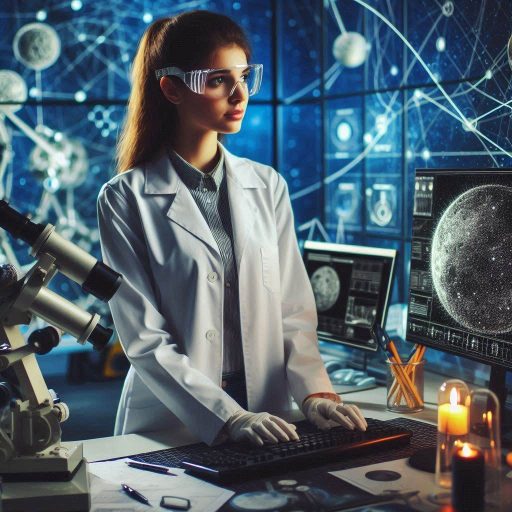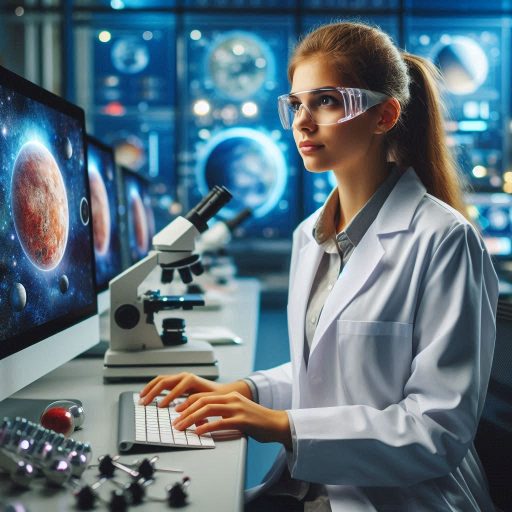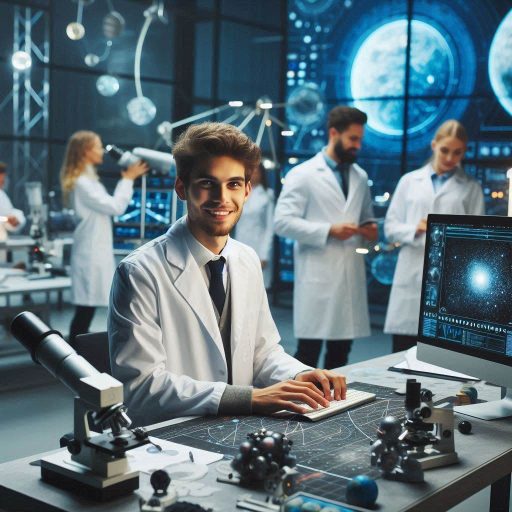Introduction
Space science encompasses the study of celestial bodies and the universe.
It involves disciplines such as astronomy, astrophysics, and planetary science.
Researchers explore the origins, evolution, and behavior of various celestial phenomena.
This field provides insights into our solar system and beyond.
Space science significantly impacts our daily lives.
Technologies developed through space exploration enhance communication and navigation.
GPS relies on satellite technology, enabling accurate location tracking for navigation systems.
Weather forecasts depend on satellite data, helping us prepare for natural disasters.
Medical advancements, like imaging technologies, have roots in space research.
Moreover, space science inspires innovation and curiosity.
It encourages young minds to explore science, technology, engineering, and mathematics (STEM).
This exploration drives economic growth and job creation in various sectors.
Space science offers invaluable contributions to our daily existence.
It fuels technological advancements and enhances our understanding of Earth and the universe.
The exploration of space enriches our lives and expands our knowledge.
Embracing space science can lead to a brighter future for humanity.
We must recognize its importance and continue to support research and exploration efforts.
Exploration of Outer Space
Advancements in Space Technology
Advancements in space technology significantly impact daily life.
New technologies developed for space exploration often benefit various industries.
For example, satellite technology has transformed global communication.
It allows instant communication through phones, emails, and social media.
Additionally, GPS technology, initially designed for military use, now guides everyday navigation.
It helps millions find their way while driving or walking.
Furthermore, remote sensing technology supports agricultural practices by providing essential data on crop health.
Innovations in space science also contribute to medical advancements.
Techniques developed for space exploration improve imaging technologies, enhancing diagnostics.
Telemedicine, influenced by satellite communication, allows patients in remote areas to consult doctors.
The development of materials in space technology often leads to consumer products.
For example, heat-resistant materials from spacecraft are now used in firefighting equipment.
Similarly, lightweight materials enhance athletic gear and everyday products.
Discoveries of New Planets and Galaxies
The exploration of space has led to significant discoveries of new planets and galaxies.
Telescopes and advanced imaging technology reveal previously unseen celestial bodies.
Scientists have identified thousands of exoplanets in recent years, expanding our understanding of planetary systems.
These discoveries challenge our understanding of the universe.
For instance, the identification of Earth-like planets raises questions about the potential for life elsewhere.
Studying these celestial bodies helps scientists understand the conditions necessary for life.
Furthermore, discoveries in distant galaxies provide insight into the universe’s evolution.
Astronomers observe the formation and behavior of galaxies over billions of years.
This knowledge enriches our understanding of cosmic history and the forces shaping the universe.
The ongoing search for new planets and galaxies drives technological innovation.
It pushes scientists to develop new instruments and methods for observation.
These advancements, in turn, enhance our ability to explore and understand the cosmos.
Impact on Understanding of the Universe
Understanding the universe significantly impacts our perspective on existence.
Space science encourages a sense of curiosity and wonder about our place in the cosmos.
It fosters appreciation for the complexity and beauty of the universe.
Moreover, discoveries in space science influence philosophical discussions about humanity‘s role.
As we uncover the mysteries of the universe, we contemplate existential questions.
The possibility of extraterrestrial life challenges traditional beliefs and inspires scientific inquiry.
Space science also plays a crucial role in international collaboration.
Countries unite for shared missions, fostering peace and cooperation.
These collaborative efforts promote global understanding and inspire future generations.
In addition, advancements in space exploration often lead to improved technology on Earth.
Many innovations developed for space have practical applications in daily life.
From weather forecasting to disaster response, space science enhances our ability to adapt and thrive.
In essence, space science profoundly impacts daily life through advancements in technology and discoveries.
It enhances communication, navigation, and medical practices.
Discoveries of new planets and galaxies reshape our understanding of the universe.
They inspire curiosity and foster international collaboration.
As we continue to explore the cosmos, space science will remain vital to human progress and understanding.
Read: The Future of Botany: Emerging Fields and Innovations
Communication and technology
Satellite Communication
Satellite communication revolutionizes how we connect and share information.
It allows instant communication across vast distances.
People rely on satellites for phone calls, television broadcasts, and internet services.
Satellite technology connects remote areas where traditional infrastructure is unavailable.
For example, many rural communities depend on satellite internet for connectivity.
This access enables education, telemedicine, and remote work opportunities.
In emergencies, satellite communication systems provide critical information when terrestrial networks fail.
Furthermore, satellite communication supports global broadcasting.
News organizations use satellites to deliver live coverage from anywhere on Earth.
This immediacy informs people about global events and crises in real-time.
The technology also enhances communication for businesses.
Companies use satellite systems for secure data transmission and video conferencing.
This capability improves collaboration and productivity among remote teams.
GPS Systems
Global Positioning System (GPS) technology has transformed navigation and travel.
GPS allows users to determine their precise location anywhere on Earth.
People rely on GPS for driving directions, hiking, and finding nearby services.
Smartphones come equipped with GPS, making navigation easy and accessible.
Apps like Google Maps and Waze provide real-time traffic updates and route planning.
This technology saves time and reduces travel frustration.
In addition, GPS plays a crucial role in logistics and transportation.
Companies use GPS to track shipments and optimize delivery routes.
This efficiency reduces costs and improves customer satisfaction.
GPS also enhances safety and security.
Emergency responders use GPS to locate individuals in distress quickly.
This capability is vital during natural disasters and urgent situations.
Weather Forecasting and Disaster Management
Weather forecasting has significantly improved due to advances in space science.
Satellites monitor atmospheric conditions and collect data for accurate predictions.
This information helps people prepare for severe weather events.
Meteorologists analyze satellite images to track storms and weather patterns.
Timely forecasts enable communities to take necessary precautions against hurricanes, floods, and tornadoes.
This preparedness can save lives and reduce property damage.
In addition to forecasting, satellites play a crucial role in disaster management.
They provide real-time imagery of affected areas during crises.
Emergency responders use this data to assess damage and allocate resources effectively.
Moreover, satellites support humanitarian efforts during disasters.
Organizations rely on satellite communication to coordinate relief efforts and deliver aid.
This connectivity ensures that help reaches those in need promptly.
Space science significantly impacts daily life through satellite communication, GPS systems, and weather forecasting.
Satellite communication connects people globally, fostering communication and collaboration.
GPS technology revolutionizes navigation, enhancing safety and convenience in travel.
Weather forecasting improves preparedness for severe weather, while satellites aid in disaster management efforts.
As technology advances, the influence of space science on our daily lives will only continue to grow.
Read: What Does a Geologist Do? Career Overview and Insights
Medical Advancements
Technology Developed for Space Travel
Technology developed for space travel often benefits everyday life.
Innovations created for astronauts frequently find applications on Earth.
For example, advanced materials used in spacecraft improve safety and performance in various industries.
One notable development is the creation of lightweight, durable materials.
These materials enhance sports equipment, making it safer and more effective.
Similarly, fire-resistant fabrics used in space suits improve safety in firefighting gear.
Additionally, life support systems designed for space missions have practical uses.
These systems contribute to air purification technologies in homes and offices.
Enhanced filtration methods remove harmful particles, improving indoor air quality for everyone.
Moreover, technologies developed for space exploration often lead to advancements in communication.
Satellite communication has evolved from space missions, enhancing global connectivity.
People now enjoy instant communication through phones, video calls, and social media.
Telemedicine and Remote Healthcare
Telemedicine has emerged as a vital service in healthcare, influenced by space technology.
It allows patients to access medical consultations without visiting a clinic.
This convenience is especially beneficial for individuals in remote areas.
Space technology contributes to telemedicine by enhancing communication capabilities.
High-resolution satellite links support secure video consultations between patients and doctors.
This connection is crucial for timely medical advice, especially in emergencies.
Furthermore, telemedicine improves healthcare access during pandemics or public health crises.
Patients can receive care while minimizing exposure to contagious illnesses.
This ability helps maintain healthcare services even under challenging conditions.
Telemedicine also enables healthcare providers to monitor patients remotely.
Wearable devices track vital signs and transmit data to healthcare professionals.
This continuous monitoring improves patient outcomes and reduces hospital visits.
Impact on Surgical Procedures and Treatments
Space science has significantly impacted surgical procedures and medical treatments.
Technologies developed for space missions have revolutionized surgical techniques.
For example, robotic surgery systems enhance precision and minimize invasiveness.
Surgeons now use robotic-assisted techniques for various procedures.
These methods reduce recovery time and improve surgical outcomes.
Patients benefit from less pain and scarring due to minimally invasive techniques.
Additionally, imaging technologies used in space exploration enhance medical diagnostics.
High-resolution imaging systems provide clearer images for better diagnosis.
Doctors can detect diseases earlier and more accurately, improving treatment effectiveness.
Moreover, advances in materials science have led to better medical implants.
Space-age materials provide greater biocompatibility and durability.
These improvements enhance the quality of life for patients receiving implants.
Space science significantly influences daily life through technology developed for space travel.
Innovations like advanced materials improve safety and communication.
Telemedicine expands healthcare access, benefiting patients in remote locations.
Finally, advancements in surgical procedures enhance patient outcomes and treatment options.
As space technology continues to evolve, its impact on healthcare and daily life will only grow.
Read: Educational Path: Becoming a Geologist in the USA

Environmental monitoring
Climate Change Research
Space science plays a crucial role in climate change research.
Satellites collect vast amounts of data about the Earth’s atmosphere.
This data helps scientists analyze trends in global temperatures and weather patterns.
Researchers use satellite imagery to monitor greenhouse gas emissions over time.
Understanding these changes is vital for developing effective climate policies.
Satellite data informs governments about rising sea levels and melting ice caps.
This information aids in predicting potential impacts on coastal communities.
Moreover, satellite observations help track deforestation and land-use changes.
Researchers can monitor how human activities affect ecosystems and biodiversity.
This knowledge supports the creation of strategies to mitigate environmental damage.
Additionally, satellite data allows for more accurate climate models.
These models predict future climate scenarios, enabling better preparation for climate-related challenges.
Policymakers can use this information to implement necessary changes and promote sustainability.
Transform Your Career Today
Unlock a personalized career strategy that drives real results. Get tailored advice and a roadmap designed just for you.
Start NowMonitoring of Natural Disasters
Satellites are essential tools for monitoring natural disasters.
They provide real-time data on various phenomena, such as hurricanes, wildfires, and earthquakes.
This information helps emergency responders prepare for and manage disaster situations.
For instance, meteorologists use satellite imagery to track hurricane paths and intensity.
Early warning systems rely on this data to alert communities in harm’s way.
Timely alerts can save lives and reduce property damage.
In addition to hurricanes, satellites monitor wildfires and provide critical information.
They detect heat signatures and assess fire spread.
This data helps firefighters allocate resources effectively and plan containment strategies.
Furthermore, satellites can monitor earthquakes through remote sensing technology.
Researchers analyze ground deformation and seismic activity using satellite data.
This monitoring improves understanding of tectonic movements and helps predict future quakes.
Conservation Efforts Based on Satellite Data
Satellite technology significantly enhances conservation efforts worldwide.
Organizations use satellite imagery to track wildlife populations and habitats.
This data informs conservation strategies and prioritizes areas needing protection.
For example, satellites help monitor illegal logging and poaching activities.
Conservationists can identify deforested areas and respond to threats quickly.
This surveillance promotes sustainable land use and protects endangered species.
Additionally, satellite data supports habitat restoration projects.
By analyzing land cover changes, scientists can assess the effectiveness of restoration efforts.
This feedback is crucial for improving conservation techniques and achieving long-term goals.
Moreover, satellites assist in monitoring climate change impacts on ecosystems.
They provide insights into how rising temperatures affect plant and animal species.
This knowledge helps develop adaptive management strategies to protect biodiversity.
Space science has a profound impact on daily life through climate change research, disaster monitoring, and conservation efforts.
Satellites provide critical data for understanding climate trends and predicting natural disasters.
Additionally, they support effective conservation strategies to protect our planet.
As technology advances, the role of space science in addressing global challenges will continue to grow.
Read: Botany Career Fairs and Networking Events
Agricultural improvements
Agricultural Monitoring
Space science significantly impacts agricultural monitoring and management.
Satellites provide valuable data about crop health and land conditions.
This information helps farmers optimize their practices for better yields.
Farmers use satellite imagery to assess soil moisture levels and identify irrigation needs.
Additionally, remote sensing technology allows farmers to monitor their fields effectively.
By analyzing satellite data, they can detect pest infestations and disease outbreaks early.
This early detection enables timely interventions, reducing crop loss.
Farmers can also assess the effects of weather patterns on their crops.
Satellite data provides insights into temperature fluctuations and rainfall distribution.
Understanding these factors helps farmers make informed decisions about planting and harvesting.
Moreover, agricultural monitoring through satellites supports sustainable practices.
Farmers can use data to implement precision agriculture techniques.
These techniques minimize resource use and maximize productivity while reducing environmental impact.
Crop Yield Predictions
Accurate crop yield predictions are essential for effective food distribution.
Space science contributes significantly to forecasting crop performance.
Satellite data allows scientists to create models that predict crop yields based on various factors.
These models consider historical data, weather conditions, and soil health.
By integrating this information, researchers can provide reliable yield forecasts.
Farmers can use these predictions to plan their production and marketing strategies.
Government agencies and organizations also rely on yield predictions for food security planning.
Accurate forecasts help them allocate resources and develop policies to ensure food availability.
This proactive approach addresses potential food shortages before they occur.
Furthermore, crop yield predictions support market stability.
Accurate data helps avoid sudden surges or drops in food prices.
By providing reliable forecasts, space science contributes to a more resilient food supply chain.
Impact on Food Security and Distribution
Space science plays a crucial role in enhancing global food security.
Agricultural monitoring and yield predictions directly impact food distribution strategies.
Accurate data allows organizations to identify areas at risk of food shortages.
Additionally, space science helps improve supply chain efficiency.
Organizations can monitor crop production in real-time and adjust distribution plans accordingly.
This responsiveness ensures that food reaches those in need promptly.
Moreover, space-based data aids in disaster response related to food security.
During natural disasters, satellite imagery provides insights into affected agricultural areas.
This information helps humanitarian organizations target their relief efforts effectively.
Furthermore, understanding global agricultural trends promotes sustainable practices.
Space science encourages the adoption of innovative farming techniques.
These practices help ensure food security for future generations by balancing productivity and environmental stewardship.
In closing, space science profoundly impacts daily life through agricultural monitoring, crop yield predictions, and food security.
Satellites provide vital data that enables farmers to optimize their practices.
Accurate yield predictions support effective food distribution strategies.
By enhancing agricultural practices, space science plays a crucial role in ensuring a stable and secure food supply for all.
Economic benefits
Development of Space Industry
The development of the space industry significantly impacts daily life.
Over the past few decades, investment in space exploration has surged.
Governments and private companies actively contribute to this growth.
They develop new technologies for space travel and exploration.
This industry has expanded beyond traditional space agencies.
Many startups focus on satellite technology, space tourism, and planetary exploration.
This shift promotes a competitive environment, leading to technological advancements.
Companies are innovating faster than ever to meet growing demands.
The rise of reusable rocket technology has reduced launch costs.
Companies like SpaceX have pioneered this approach.
Their innovations make space more accessible to various sectors.
As a result, more businesses consider space as a viable market.
Job Creation in Various Sectors
The growth of the space industry creates numerous job opportunities.
Skilled professionals in engineering, science, and technology are in high demand.
These jobs range from research positions to hands-on engineering roles.
Educational institutions have responded by offering specialized programs.
Universities now provide degrees focused on aerospace engineering and astrophysics.
Graduates from these programs fill essential roles in the expanding industry.
Additionally, support industries benefit from space development.
Manufacturing, logistics, and IT sectors see increased demand for skilled workers.
This ripple effect creates job opportunities in various fields, stimulating economic growth.
Moreover, space initiatives foster international collaboration.
Countries worldwide partner on projects, enhancing global job opportunities.
Professionals from different backgrounds contribute their expertise to shared goals.
Innovation and Entrepreneurship Opportunities
The growing space industry fosters innovation and entrepreneurship.
Startups are emerging to tackle challenges in satellite technology and space exploration.
Entrepreneurs are increasingly drawn to this dynamic field.
Innovation in satellite communications has transformed industries.
Companies develop new services for telecommunications and data collection.
This evolution opens doors for businesses in various sectors.
Furthermore, the demand for satellite-based applications grows.
Industries like agriculture, healthcare, and transportation benefit from space technology.
Entrepreneurs create solutions that leverage satellite data to improve efficiency.
Incubators and accelerators support space-focused startups.
These programs provide resources, mentorship, and funding opportunities.
Entrepreneurs gain access to valuable networks, helping them launch successful ventures.
Moreover, advancements in space technology inspire new business models.
Companies explore ways to commercialize space exploration.
This entrepreneurial spirit leads to breakthroughs in technology and services.
The development of the space industry impacts daily life through job creation and innovation.
The industry offers numerous job opportunities across various sectors.
As startups and established companies drive advancements, entrepreneurs find new avenues for success.
The ongoing growth of the space industry fosters a vibrant ecosystem that benefits society as a whole.
By embracing this transformation, we can look forward to a future where space technology enhances our daily lives.
Education and Research
Inspiration for Future Generations
Space science inspires future generations to pursue careers in STEM fields.
Young students dream of becoming astronauts, engineers, and scientists.
They look to space missions for motivation and excitement.
Historic events, like the moon landing, captivate their imaginations.
These achievements showcase what humanity can accomplish through perseverance and innovation.
Educational programs incorporate space science into their curricula.
Schools encourage students to explore astronomy and space technology.
Programs promote hands-on learning, igniting curiosity about the universe.
Science fairs often feature projects related to space exploration.
Such initiatives help students envision a future in space science.
Media coverage of space missions further fuels interest.
Documentaries, movies, and books highlight space exploration’s wonders.
These stories inspire children and young adults to think big.
Space science also promotes creativity and critical thinking skills.
Engaging with these subjects helps students develop problem-solving abilities.
Opportunities for Scientific Research
Space science offers numerous opportunities for scientific research.
Researchers investigate cosmic phenomena and their implications for Earth.
They explore topics like climate change, planetary geology, and astrophysics.
Space missions provide valuable data for understanding these complex issues.
NASA and other space agencies prioritize research initiatives.
They collaborate with universities and research institutions worldwide.
Such partnerships enhance scientific discoveries and drive innovation.
Researchers analyze data from satellites and space probes to answer critical questions.
Additionally, private companies contribute to space research.
Organizations like SpaceX and Blue Origin invest in innovative technologies.
They develop new tools and systems for conducting experiments in space.
This collaboration expands research opportunities, benefiting both public and private sectors.
Collaboration Between Scientists Worldwide
Collaboration among scientists worldwide advances space science.
International partnerships enhance research efforts and share resources.
Agencies like ESA and NASA work together on various missions.
They combine expertise to tackle complex scientific challenges.
Global conferences and workshops foster collaboration among researchers.
Scientists share findings and discuss future projects.
These events promote networking and knowledge exchange across borders.
Interdisciplinary collaborations also emerge, integrating fields like biology, engineering, and physics.
Additionally, open-access platforms facilitate global cooperation.
Researchers share data and findings, promoting transparency in science.
This approach accelerates advancements in understanding the universe.
Scientists can build on each other’s work, fostering innovation.
Moreover, space exploration encourages a sense of unity.
Countries collaborate for shared goals, like Mars exploration and asteroid mining.
This teamwork exemplifies how science transcends national boundaries.
Together, scientists strive to unlock the universe’s mysteries.
In summary, space science profoundly impacts daily life by inspiring future generations.
It offers significant opportunities for scientific research and fosters collaboration among scientists worldwide.
As young people pursue careers in this field, they contribute to our understanding of the universe.
By working together, scientists push the boundaries of knowledge and innovation, ensuring a brighter future for all.
See Related Content: Building a Career in Soil Conservation
Conclusion
Space science plays a crucial role in our everyday lives.
It enhances our understanding of Earth and its environment.
Innovations from space research improve weather forecasting and disaster management.
Technologies like GPS and satellite communication stem from space exploration.
These advancements make travel, navigation, and communication more efficient.
Continued support and funding for space exploration remain vital.
Governments and private organizations should invest in new missions and research.
With financial backing, we can uncover more about our universe and develop innovative technologies.
Funding space science can lead to groundbreaking discoveries that benefit humanity.
Individuals can take an active role in promoting space science.
Stay informed about the latest developments in space exploration.
Follow space agencies and educational platforms for updates.
Engaging with local science centers or attending talks can deepen your understanding.
Share your knowledge with others and inspire future generations.
Encourage young people to pursue careers in science and technology.
Together, we can foster a culture that values space science.
Supporting research and exploration will pave the way for a brighter future.
Let‘s commit to investing in space science for the benefit of all.
Stay curious, stay engaged, and embrace the wonders of the universe.
Transform Your LinkedIn into a Job Magnet
Picture recruiters reaching out to you daily. We craft personalized LinkedIn profiles that stand out, boosting your visibility in ways others can't. Elevate your career now.
Upgrade Now



